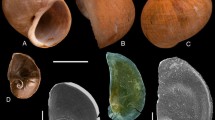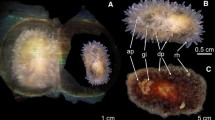Abstract
Oviposition and embryonic-larval development are described for the muricacean snail Thais (Stramonita) chocolata from the Southeast Pacific coast. As with numerous other muricacean snails, this species engages in communal egg laying, with females depositing egg capsules in clusters on subtidal rocks. Each cluster of capsules contains 100–150 pedunculate, ampulliform egg capsules, with each capsule containing an average of 2,600 small (130 μm) eggs. Intracapsular development was followed using light and scanning electron microscopy to describe the successive embryonic stages of the species. Free-swimming veliger larvae of about 225 μm length were released from capsules after 49 days incubation at 13.6°C. The planktotrophic larvae were cultured in seawater aquaria by feeding with pure cultures of phytoplankton, recording growth and form of the larvae. Larvae reached competence after 4 months at 22°C, at 1,450–1,740 μm in size, and a few larvae were observed through metamorphosis and early definitive growth. The embryonic-larval development of T. chocolata coincides with the general characteristics of the ontogeny observed in other Thais species as well as of other genera of the Rapaninae such as Concholepas. This lent support to grouping these genera into a single clade. The lack of knowledge of the development of free larvae of Thais spp. means that we do not know whether these similarities also include an extensive larval phase as generally characteristic of other members of the clade. The mode of development may be useful in characterizing some clades of this family. Thus for example, the transference of some Thais to the genus Nucella (Subfamily Ocenebrinae) is supported by differences in the mode of embryonic development, which differentiates these subfamilies. Paleobiological data reported for Neogastropoda allow postulation of primitiveness in planktotrophic larval development compared to more recent developmental strategies such as direct development of different types, which characterize various clades of this family.






Similar content being viewed by others
References
Amio M (1963) A comparative embryology of marine gastropods, with ecological considerations. J Shimonoseki Coll Fish 12:229–358
Barkati S, Ahmed M (1983) Studies on reproductive biology of the Northern Arabian Sea. II. Egg capsules and larvae of four species of Thais. Veliger 26:30–36
Beu AG (1970) Taxonomic position of Lippistes pehuensis Marwick, with a review of the species of Concholepas (Gastropoda, Muricidae). J Malacol Soc Aust 2: 39–46
Butler PA (1954) The southern oyster drill. Proc Natl Shellfish Assoc 44:67–75
Cañete JI (1992) Cápsulas ovígeras de cinco especies de neogastrópodos de la zona Norte de Chile. Bol Soc Biol Concepción (Chile) 63:43–49
Castilla JC (1988) A literature review (1980–1988) on Concholepas concholepas (Gastropoda, Muricidae): fishery problems and experiences on re-stocking. Biol Pesq (Chile) 17:9–19
Castilla JC, Camus PA (1992) The Humboldt–El Niño scenario: coastal benthic resources and anthropogenic influences with particular reference to the 1982/83 ENSO. S Afr J Mar Sci 12:703–712
Collins TM, Frazer K, Palmer AR, Vermeij GJ, Brown WM (1996) Evolutionary history of northern hemisphere Nucella (Gastropoda, Muricidae): molecular, morphological, ecological, and paleontological evidence. Evolution 50:2287–2304
Costello DP, Davidson ME, Eggers A, Fox MH, Henley, C (1957) Methods for obtaining and handling marine eggs and embryos. Marine Biology Laboratory, Woods Hole, Massachusetts
D’Asaro CN (1966) The egg capsules, embryogenesis, and early organogenesis of a common oyster predator, Thais haemastoma floridana (Gastropoda: Prosobranchia). Bull Mar Sci 16:884–914
D’Asaro CN (1970) Egg capsules of prosobranch mollusks from south Florida and the Bahamas and notes on spawning in the laboratory. Bull Mar Sci 20:414–440
D’Asaro CN (1988) Micromorphology of neogastropod egg capsules. Nautilus 102:134–148
D’Asaro CN (1991) Gunnar Thorson’s world-wide collection of prosobranch egg capsules: Muricidae. Ophelia 35:1–101
DiSalvo LH (1988) Observations on the larval and post-metamorphic life of Concholepas concholepas (Bruguière, 1789) in laboratory culture. Veliger 304:358–368
DiSalvo LH, Carriker MR (1994) Planktonic, metamorphic, and early benthic behavior of the Chilean loco Concholepas concholepas (Muricidae, Gastropoda, Mollusca). J Shellfish Res 13:57–66
Gajardo G, Cancino JM, Navarro JM (2002) Genetic variation and population structure in the marine snail Chorus giganteus (Gastropod: Muricidae), an overexploited endemic resource from Chile. Fish Res 55:329–333
Gallardo CS (1973) Desarrollo intracapsular de Concholepas concholepas (Brugière) (Gastropoda, Muricidae). Publicación Ocasional no. 16, Museo Nacional de Historia Natural, Santiago, Chile, pp 3–16
Gallardo CS (1979) El ciclo vital del Muricidae Concholepas concholepas y consideraciones sobre sus primeras fases de vida en el bentos. Biol Pesq (Chile) 12:79–89
Gallardo CS (1980) Adaptaciones reproductivas en gastrópodos muricáceos de Chile; conocimiento actual y perspectivas. Inv Mar Valparaiso 8:115–128
Gallardo CS (1981) Posturas y estadio de eclosión del gastrópodo Muricidae Chorus giganteus (Lesson, 1829). Stud Neotrop Fauna Environ 16:35–44
Gallardo CS (1994) Efecto de diferentes salinidades en la sobrevivencia embrionaria y desarrollo intracapsular del gastrópodo Concholepas concholepas (Brugière, 1789) bajo condiciones de laboratorio. Rev Biol Mar Valparaiso 29:263–279
Gallardo MH, Carrasco JI (1996) Genetic cohesiveness among populations of Concholepas concholepas (Gastropoda, Muricidae) in Southern Chile. J Exp Mar Biol Ecol 197:237–249
Gallardo CS, González K (1994) Oviposturas y desarrollo intracapsular de Xanthochorus cassidiformis (Blainville, 1832) (Gastropoda: Muricidae) de la costa sur de Chile. Gayana Zool 58:79–90
Garrido O, Gallardo CS (1993) Ultraestructura de la cápsula ovífera de Concholepas concholepas (Brugière, 1789) (Gastropoda: Muricidae). Rev Biol Mar Valparaiso 28:191–201
González KA, Gallardo C S (1999) Embryonic and larval development of the muricid snail Chorus giganteus (Lesson, 1829) with an assessment of the developmental nutrition source. Ophelia 51:77–92
Hancock DA (1956) The structure of the capsule and the hatching process in Urosalpinx cinerea (Say). Proc Zool Soc Lond 127:565–571
Hansen TA (1983) Modes of larval development and rates of speciation in early tertiary neogastropods. Science 220:501–502
Jablonski D, Lutz RA (1983) Larval ecology of marine benthic invertebrates: paleobiological implications. Biol Rev 58:21–89
Kool SP (1993a) Phylogenetic analysis of the Rapaninae (Neogastropoda: Muricidae). Malacologia 35:155–259
Kool SP (1993b) The systematic position of the genus Nucella (Prosobranchia: Muricidae: Ocenebrinae). Nautilus 107:43–57
Lara E, Montes E (1989) Desarrollo larvario del recurso loco (Concholepas concholepas). Estudio de Repoblamiento de Recursos Bentónicos, Area Piloto IV región. II. Investigaciones Específicas. CORFO-IFOP (A.P. 89/3b), pp 41–66
LeBoeuf R (1972) Thais emarginata (Deshayes): description of veliger and egg capsules. Veliger 14:205–211
Lyons A, Spight TM (1973) Diversity of feeding mechanisms among embryos of Pacific northwest Thais. Veliger 16:189–194
Moreno CA, Reyes A, Asencio G (1993a) Habitat and movements of the recruits of Concholepas concholepas (Mollusca; Muricidae) in the rocky intertidal of southern Chile. J Exp Mar Biol Ecol 171:51–61
Moreno CA, Asencio G, Ibáñez S (1993b) Patrones de asentamiento de Concholepas concholepas (Brugière, 1789) (Mollusca: Muricidae) en la zona intermareal rocosa de Valdivia, Chile. Rev Chil Hist Nat 66:93–101
Palumbi SR (1995) Using genetics as an indirect estimator of larval dispersal. In: McEdward L (ed) Ecology of marine invertebrate larvae. CRC, New York, pp 369–387
Pechenik JA, Chang SC, Lord A (1984) Encapsulated development of the marine prosobranch gastropod Nucella lapillus. Mar Biol 78:223–229
Phillips BF (1969) The population ecology of the whelk Dicathais aegrota in Western Australia. Aust J Mar Freshw Res 20:225–265
Ramorino L (1975) Ciclo reproductivo de Concholepas concholepas en la zona de Valparaíso. Rev Biol Mar Valparaiso 15:149–177
Roller RA, Stickle WB (1988) Intracapsular development of Thais haemastoma canaliculata (Gray) (Prosobranchia: Muricidae) under laboratory conditions. Am Malacol Bull 6:189–197
Scheltema RS (1971) Larval dispersal as a means of genetic exchange between geographically separated populations of shallow-water benthic marine gastropods. Biol Bull 140:284–322
Scheltema RS (1986) Long-distance dispersal by planktonic larvae of shoal-water benthic invertebrates among Central Pacific Islands. Bull Mar Sci 39:241–256
SERNAPESCA (2001) Anuario de estadísticas en pesca 2002. Servicio Nacional de Pesca, Santiago, Chile, pp 125
Spight TM (1976) Ecology of hatching size for marine snails. Oecologia 24:283–294
Stotz W, Lancellotti DA, Martínez DJ, De Amesti P, Pérez E (1991) Variación temporal y espacial del registro de juveniles recién asentados de Concholepas concholepas en el intermareal rocoso de la IV Región, Chile. Rev Biol Mar Valparaiso 26:351–361
Strathmann M (1987) Reproduction and development of marine invertebrates of the northern Pacific coast. University of Washington Press, Seattle, Washington
Turner RD, Boyle PJ (1974) Studies of bivalve larvae using the scanning electron microscope and critical point drying. Bulletin for 1974. American Malacological Union, pp 59–65
Vermeij GJ, Carlson SJ (2000) The muricid gastropod subfamily Rapaninae: phylogeny and ecological history. Paleobiology 26:19–46
Vokes EH (1996) One last look at the Muricidae. Am Conchol 24:4–6
Acknowledgements
We would like to thank Unidad de Producción de la Universidad Católica del Norte and Mr. Helmo Pérez for cooperation during this study. The preparation of the manuscript was partially financed by Proyect DID-UACH 2001–02.
Author information
Authors and Affiliations
Corresponding author
Additional information
Communicated by O. Kinne, Oldendorf/Luhe
Rights and permissions
About this article
Cite this article
Soledad Romero, M., Gallardo, C.S. & Bellolio, G. Egg laying and embryonic-larval development in the snail Thais (Stramonita) chocolata (Duclos, 1832) with observations on its evolutionary relationships within the Muricidae. Marine Biology 145, 681–692 (2004). https://doi.org/10.1007/s00227-004-1368-9
Received:
Accepted:
Published:
Issue Date:
DOI: https://doi.org/10.1007/s00227-004-1368-9




